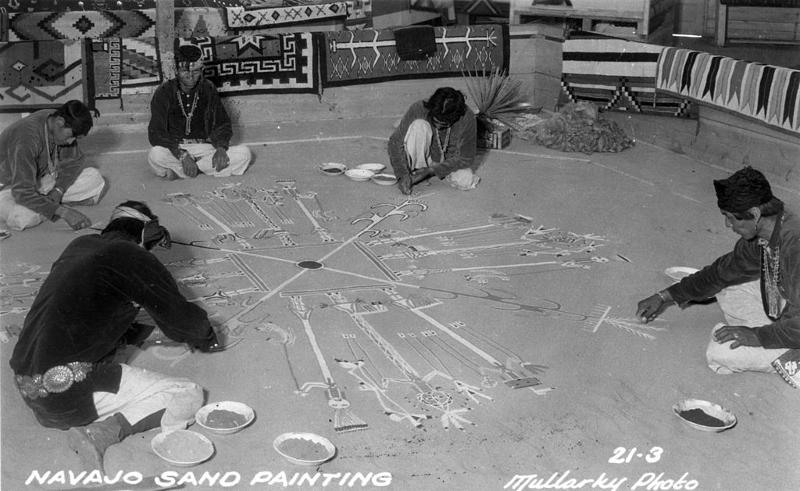Navajo Ceremonies
 When the world is in a state of hózhó there is no illness or misfortune. However, many things can throw the world out of balance, including ghosts, lightening, snakes, coyotes, and bears. Navajo ceremonies are designed to restore hózhó when this happens. Such ceremonies can be conducted in order to bring about healing or simply to ensure general well being or wealth.
When the world is in a state of hózhó there is no illness or misfortune. However, many things can throw the world out of balance, including ghosts, lightening, snakes, coyotes, and bears. Navajo ceremonies are designed to restore hózhó when this happens. Such ceremonies can be conducted in order to bring about healing or simply to ensure general well being or wealth.
Whether the goal is healing or general well being, all ceremonies are designed to attract the attention of the Diyin Diné'e in order to persuade them to bestow blessings and restore hózhó. The Diyin Diné'e are attracted by carefully following ceremonies that can include rituals, chants, and sandpaintings. If the performance is judged to be correct and complete, the Diyin Diné'e will come.
The Navajo ceremonial system is extremely complex, involving numerous "chantway" ceremonies. For example, Enemyway ceremonies are used to exercise ghosts and are used to protect warriors for slain enemies; Blessingway ceremonies are conducted to invoke blessings, and may be held whenever a new home is completed, a woman is in childbirth, or to protect livestock; and Nightway ceremonies are healing rituals. Within each of these general categories there are numerous rituals and which should be used will depend on the goal of the ritual and the cause (in cases of illness) of the misfortune. For example, because insanity can be caused by coming in contact with a moth, the Mothway chant (a type of Nightway ceremony) is used to heal mental illness. Rheumatism, sore throats, and stomach problems can be caused by contact with a snake, and require that a Beautyway chant be performed.
If a person is sick a hand trembler must be hired to determine the cause of the illness; a hand trembler is a specialist capable of determining the causes of illness while in a trance-like state. After determining the cause, and thus which ritual should be performed, a hataali (or a ritual singer) will be hired to carry out the ceremony. To correctly carry out the ritual, the hataali must have memorized hundreds of songs, dozens of prayers, and numerous complicated and intricate sand paintings, for if a single error is made in carrying out the ritual, the Diyin Diné'e will not come. Because of the complexity of the rituals, most hataali know only one or two of the dozens of ceremonies used in Navajo society.
Drawing of a Navajo man making a sand painting, by Harrison Begay
Source - http://sirismm.si.edu/naa/74-7/08788300.jpg

Many rituals require the use of sandpaintings. These large images (most measure about six feet across) can be quite complicated and must follow precise standards; they can take four to six men anywhere from between three and five hours to complete. The sandpainting image attracts the Diyin Diné'e, who then reciprocate by bestowing the image with healing power. The patient is healed by sitting on the image to absorb its healing power; afterwards, the sandpainting is destroyed to rid the danger that is now associated with it.
Navajo men working on a sandpainting, ca. 1890-1910
Source - https://upload.wikimedia.org/wikipedia/commons/8/89/Navajos_sandpainting.jpg
Perhaps the most important ceremony in Navajo society is the kinaalda, the girl's coming of age ceremony. Patterned after the puberty ceremony first held for Changing Woman, a girl's kinaalda spans four days. During the kinaalda other other women work her body with their hands in an effort to "re-mould" her into the image of Changing Woman, the ideal woman. On the final day, once she is a woman, the girl will lay her hands on others in the community to bestow blessings. Watch the video (below) on kinaalda.
Click on next page to continue.
